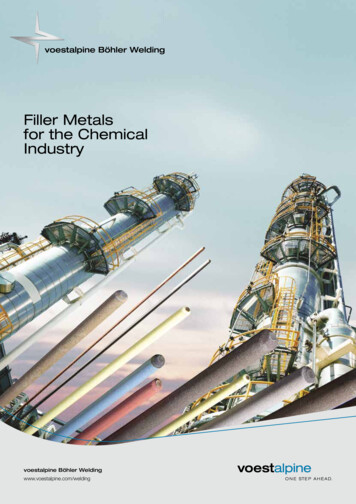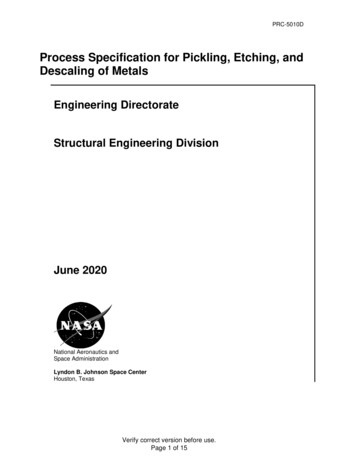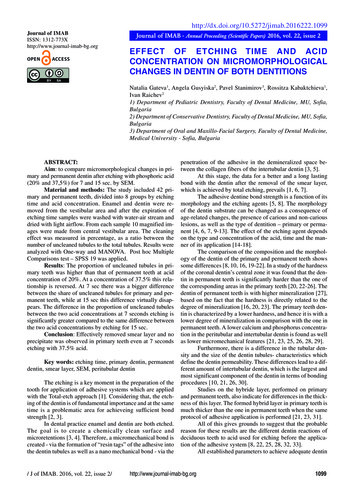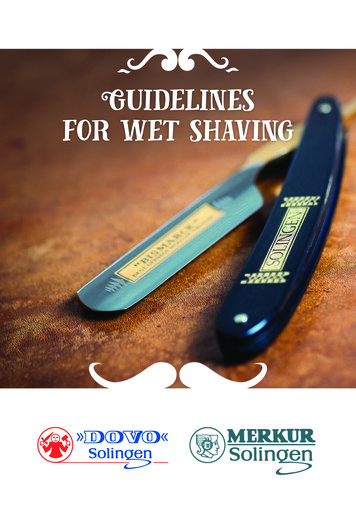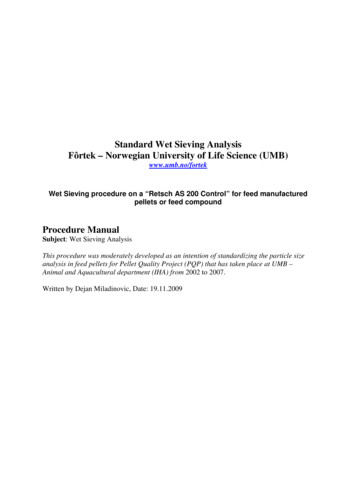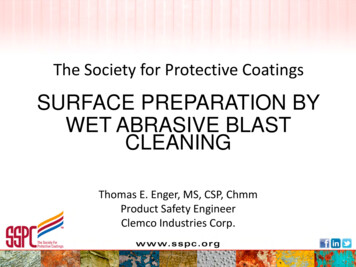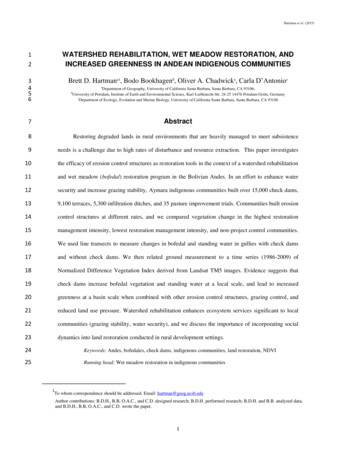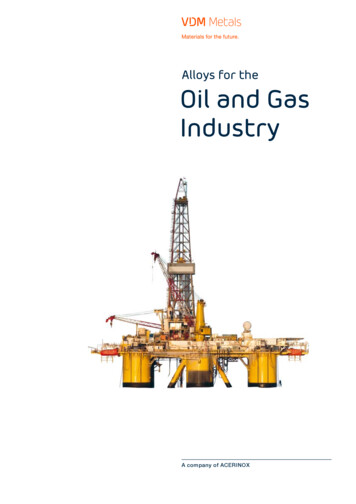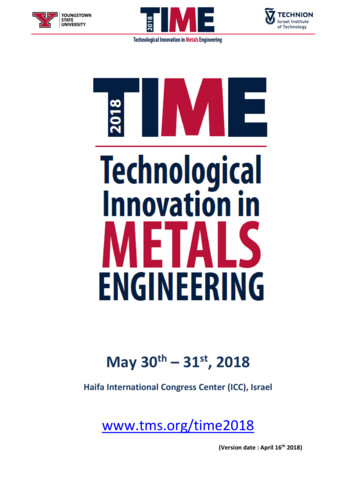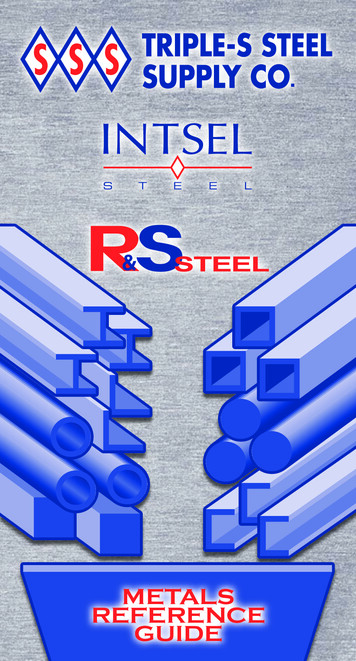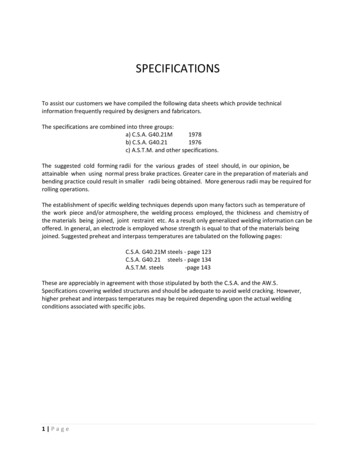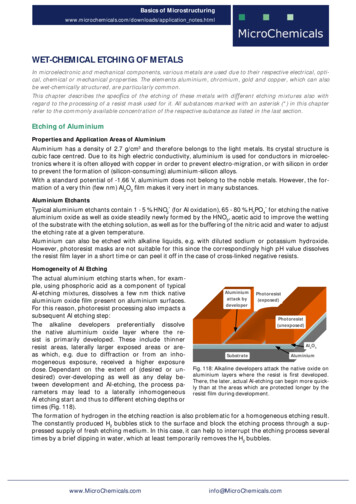
Transcription
01Basics of MicrostructuringMicroChemicals – Fundamentals of loads/application notes.htmlWET-CHEMICAL ETCHING OF METALSIn microelectronic and mechanical components, various metals are used due to their respective electrical, optical, chemical or mechanical properties. The elements aluminium, chromium, gold and copper, which can alsobe wet-chemically structured, are particularly common.This chapter describes the specifics of the etching of these metals with different etching mixtures also withregard to the processing of a resist mask used for it. All substances marked with an asterisk (*) in this chapterrefer to the commonly available concentration of the respective substance as listed in the last section.Etching of AluminiumProperties and Application Areas of AluminiumAluminium has a density of 2.7 g/cm3 and therefore belongs to the light metals. Its crystal structure iscubic face centred. Due to its high electric conductivity, aluminium is used for conductors in microelectronics where it is often alloyed with copper in order to prevent electro-migration, or with silicon in orderto prevent the formation of (silicon-consuming) aluminium-silicon alloys.With a standard potential of -1.66 V, aluminium does not belong to the noble metals. However, the formation of a very thin (few nm) Al2O3 film makes it very inert in many substances.Aluminium EtchantsTypical aluminium etchants contain 1 - 5 % HNO3* (for Al oxidation), 65 - 80 % H3PO4* for etching the nativealuminium oxide as well as oxide steadily newly formed by the HNO3, acetic acid to improve the wettingof the substrate with the etching solution, as well as for the buffering of the nitric acid and water to adjustthe etching rate at a given temperature.Aluminium can also be etched with alkaline liquids, e.g. with diluted sodium or potassium hydroxide.However, photoresist masks are not suitable for this since the correspondingly high pH value dissolvesthe resist film layer in a short time or can peel it off in the case of cross-linked negative resists.Homogeneity of Al EtchingThe actual aluminium etching starts when, for example, using phosphoric acid as a component of typicalAluminiumAl-etching mixtures, dissolves a few nm thick nativePhotoresistattack by(exposed)aluminium oxide film present on aluminium surfaces.developerFor this reason, photoresist processing also impacts asubsequent Al etching step:PhotoresistlackThe alkaline developers preferentially dissolve(unexposed)the native aluminium oxide layer where the reOsist is primarily developed. These include thinnerAl2O3resist areas, laterally larger exposed areas or areas which, e.g. due to diffraction or from an inhoSubstrateAluminiummogeneous exposure, received a higher exposuredose. Dependant on the extent of (desired or un- Fig. 118: Alkaline developers attack the native oxide ondesired) over-developing as well as any delay be- aluminium layers where the resist is first developed.There, the later, actual Al-etching can begin more quicktween development and Al-etching, the process pa- ly than at the areas which are protected longer by therameters may lead to a laterally inhomogeneous resist film during development.Al etching start and thus to different etching depths ortimes (Fig. 118).The formation of hydrogen in the etching reaction is also problematic for a homogeneous etching result.The constantly produced H2 bubbles stick to the surface and block the etching process through a suppressed supply of fresh etching medium. In this case, it can help to interrupt the etching process severaltimes by a brief dipping in water, which at least temporarily removes the H2 com
01Basics of MicrostructuringMicroChemicals – Fundamentals of loads/application notes.htmlCompatibility and SelectivityAll of our photoresists are sufficiently stable in H3PO4/HNO3-based etching mixtures to be used as a resistmask, at least after a sufficient hardbake.The etching rate of aluminium etching based on H3PO4/HNO3 mixtures is strongly temperature-dependent and doubles every few degrees of temperature rise. Aluminium alloyed with only a few percent siliconhas a similar etching rate as pure aluminium.Copper is etched by this Al-etchant much more greatly than aluminium, nickel is comparatively weaklyetched. Titanium, chromium and silver are not noticeably etched, precious metals such as gold, platinumare not etched at all.Our Aluminium EtchantOur aluminium etchant TechniEtch Al80 has the composition H3PO4* : HNO3* : CH3COOH* : H2O 80 %: 5 %: 5 % : 10% comes in 2.5 L containers in MOS quality.Etching of ChromiumProperties and Application Areas of ChromiumChromium is used in the field of microstructuring for the production of photo masks as well as adhesionpromoters for the subsequently applied metal films because of its high hardness and good adhesion tomany materials.Chromium EtchantsChromium etchants are usually based on ceric ammonium nitrate (NH4)2[Ce(NO3)6] with perchloric acid(HClO4) as an optional additive. Perchloric acid is almost completely dissociated as an extremely strongacid in aqueous solution (PKS value -8) and serves as a very strong oxidising agent for the stabilisation ofthe ceric ammonium nitrate. Ceric ammonium nitrate itself is a very powerful oxidising agent.The sum formula for the etching of chromium with ceric ammonium nitrate and perchloric acid is3 (NH4)2Ce(NO3)6 Cr Cr(NO3)3 3(NH4)2Ce(NO3)5according to which the cerium is reduced from the oxidation stage IV to III and the chromium is oxidisedto oxidation stage III. The chromium nitrate, which during the etching process forms a dark, constantlynew formation on the chromium layer, is very soluble in water and thus in the chromate etchants.Compatibility and SelectivityAll of our photoresists are sufficiently stable in ceric ammonium nitrate and perchloric acid-based etchingmixtures to be used as resist masks.Copper, silver and vanadium are strongly etched by this etching mixture. Aluminium, titanium, tungsten and nickel experience only a weak etching. The noble metals gold, platinum and palladium are notetched. Experience has shown that with copper in (electrical) contact with chromium, a greatly reducedetching rate of chromium can occur.Our Chromium EtchantsOur chromium etchant TechniEtch Cr01 consists of ceric ammonium nitrate : Perchloric acid : water 10.9% : 4.25 % : 84.85 % with an etching rate of about 60 nm/minute at room temperature comes in 2.5 L containers in VLSI quality.Etching of GoldProperties and Application Areas of GoldGold is a metal of very high density of 19.3 g/cm3, its crystal structure is cubic face centred. With a standard potential 1.5, gold belongs to the noble metals. The electron configuration [Xe] 4f145 d106 s1 stronglyprevents the oxidation of gold: The completely occupied 5d orbital extends beyond the single valenceelectron which hereby is well shielded against any reaction partners.Wet chemical etching of gold therefore requires a strong oxidiser for the separation of the unpaired va-www.MicroChemicals.cominfo@MicroChemicals.com
01Basics of MicrostructuringMicroChemicals – Fundamentals of loads/application notes.htmllence electron, as well as a complexing agent which suppresses the reassembly of oxidised gold atomsback into the crystal.By virtue of this high chemical stability against most acids and bases, gold is used in microelectronics as amaterial for electrical contacts or their protection.Gold Etching with HCl/HNO 3Mixtures of nitric acid and hydrochloric acid (in a mixing ration of 1 : 3 also called aqua regiaare able to etch gold at room temperature. The very strong oxidative effect of this mixture stems fromthe formation of nitrosyl chloride (NOCl) via the reaction HNO3 3 HCl NOCl 2 Cl 2 H2O, while free Clradicals formed in the solution keep the noble metal dissolved as Cl-complex (chloroauric acid HAuCl4).Aqua regia consumes itself and decomposes under formation of nitrous gases and chlorine gas.The etch rate of aqua Regia for gold is approx. 10 μm/min (at room temperature) and can be increased toseveral 10 μm/min at elevated temperatures.Palladium, aluminium, copper and molybdenum are also etched at room temperature in aqua regia. Foretching platinum or rhodium, the etching solution has to be heated to attain a reasonable etch rate. Etching of iridium requires strongly heated (boiling) aqua regia.Silver is not attacked by aqua regia due to the formation of a silver chloride passivation film. Chromium,titanium, tantalum, zirconium, hafnium and niobium also form a very stable passivation film (in many cases, the metal oxide) protecting the metal against the attack of aqua regia at least at room temperature.For same reason, tungsten reveals a very slow etch rate in aqua regia.Gold Etching with KI/I2Gold and iodine form gold iodide via 2 Au I2 2 AI. The solubility of AI is improved by adding KI to thesolution. Iodine/iodide can be substituted by other halogenides excepting fluorine which does not formsoluble gold compounds.In a mixing ratio KI : I2 : H2O 4 g : 1 g : 40 ml, a room temperature etch rate of approx. 1 μm/min gold isattained. Copper reveals a comparable etch rate, while nickel is only etched when in contact with gold.Gold Etching with CyanidesAqueous solutions of the very toxic sodium cyanide (NaCN) or, respectively, the also very toxic potassium cyanide (KCN) dissolve gold via the formation of the soluble cyano-complex [Au(CN)2]. This reactionrequires oxygen from the air or supplied by decomposing hydrogen peroxide H2O2 added to the etchingsolution.In addition to gold, cyanide solutions etch, for example, silver and copper, which also form water soluble,cyano-complexes.Our Gold Etch ACI2Our ready-to-use gold etchant solution TechniEtch ACI2 is based on a potassium iodide/iodine solutionwhich we offer in 2.5 L containers in VLSI quality.Copper EtchingProperties and Application Areas of CopperDue to its high electrical conductivity and its lower cost compared to silver, copper is widely used as a material for conductors in microelectronics as well as in printed circuit boards. Due to the lack of possibilityof dry-chemical structuring by means of plasma etching, wet-chemical etching methods have to be usedfor this purpose, if necessary, in combination with a subsequent fortification by electroplating.Copper EtchingCopper is etched by (also diluted) nitric acid as well as saturated 30% Fe (Cl)3 solution.Mixtures of NH4OH and H2O2 etch copper as well.www.MicroChemicals.cominfo@MicroChemicals.com
01Basics of MicrostructuringMicroChemicals – Fundamentals of loads/application notes.htmlNickel EtchingProperties and Application Areas of NickelThe transition metal nickel with a density of 8.9 g/cm3 is one of the heavy metals. Its crystal structure iscubic face centred. Due to its hardness and high chemical resistance, nickel coatings are used as corrosion protection of surfaces against chemical and mechanical attack.Nickel EtchingOxidising acids coat nickel with a passivating oxide layer, which prevents further etching. For this reason,nickel etching mixtures require a medium which is able to dissolve the initially present as well as the constantly forming oxide, as well as an oxidiser.Like titanium, nickel can be etched using H2O2 (for the oxidation of Ni) and HF (dissolution of oxide). As anoxidiser, nitric acid and instead of the HF, hydrochloric acid can be used. An aqueous 30% Fe(Cl)3 solutionalso etch nickel.Silver EtchingProperties and Application Areas of SilverThe noble metal silver’s crystal structure is cubic face centred. Silver has the highest electrical conductivity of all metals and is used in microelectronics as a material for conductors, where the requirement formaximum electrical conductivity warrants the higher material costs as compared to copper.Silver EtchingThe corresponding etching solutions require a component which oxidises silver, and a further one thatdissolves silver oxide.In addition to the KI / I2 / H2O etching solution described in the section Gold etching, silver is also etchedby NH4OH* : H2O2* : methanol 1 : 1 : 4. The toxic methanol is not a mandatory component and can beomitted with a loss in etching uniformity or replaced by water. A further etching mixture for silver is anaqueous solution of HNO3* : HCl* : H2O 1 : 1 : 1.Titanium EtchingProperties and Application Areas of TitaniumTitanium is often used as a very hard and corrosion-resistant metal in microstructuring as an adhesivelayer between the substrate and metal films deposited on top of it. As separating layer between siliconand aluminium, it serves as a barrier against the diffusion of Si in Al in order to prevent the so-called "aluminium spiking" where Al diffuses into spaces left by diffused Si and thereby may cause short circuits.Titanium EtchingTitanium forms a very stable oxide layer on air to be etched by HF, which is thus often a component oftitanium etchants. H2O2 is suitable for the oxidation of the underlying layers as a second component. Ina mixing ratio of HF* : H2O2* : H2O 1 : 1 : 20, titanium can be etched at room temperature with approx. 1µm/min.Standard ConcentrationsAll concentration data of all substances mentioned in this chapter and marked with a (*) refer to followingbasic concentrations:HCl* 37 % HCl in H2OHNO3* 70 % HNO3 in H2OH2SO4* 98 % H2SO4 in H2OHF* 50 % HF in H2O*H2O2 30 % H2O2 in H2OH3PO4* 85 % H3PO4 in H2ONH4OH* 29 % NH3 in H2OCH3COOH* 99 % CH3COOH in H2Owww.MicroChemicals.cominfo@MicroChemicals.com
AZ 1500PositiveImproved adhesion for wet etching, nofocus on steep resist sidewallsAZ P4000Spray coatingDip coatingSteep resist sidewalls, high resolutionand aspect ratio for e. g. dry etching orplatingPositive(chem.amplified)Steep resist
The etch rate of aqua Regia for gold is approx. 10 μm/min (at room temperature) and can be increased to several 10 μm/min at elevated temperatures. Palladium, aluminium, copper and molybdenum are also etched at room temperature in aqua regia. For etching platinum or rhodium, the etching solution has to be heated to attain a reasonable etch rate. Etch- ing of iridium requires strongly heated .
